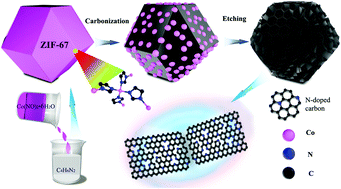High pyridine N-doped porous carbon derived from metal–organic frameworks for boosting potassium-ion storage†
Abstract
Potassium ion batteries (PIBs) have been regarded as promising energy storage devices for large-scale energy storage owing to the abundance of potassium resources. In this work, high pyridine N-doped porous carbon synthesized at 600 °C (NPC-600) derived from metal–organic frameworks (MOFs) has been fabricated and employed as the anode material for PIBs. NPC-600 can deliver a high reversible specific capacity (587.6 mA h g−1 at 50 mA g−1), outstanding rate properties (186.2 mA h g−1 at 2 A g−1) and cycling performance (231.6 mA h g−1 at 500 mA g−1 after 2000 cycles). This excellent electrochemical performance could be attributed to the increased amounts of pyridine N and neglectable change of the interlayer space during the potassiation/depotassiation process of NPC-600, which can provide additional adsorption sites to “capture” more K ions and ensure structural stability. This simple synthesis approach and unique structure make NPCs a promising candidate for next generation rechargeable PIBs.

- This article is part of the themed collection: 2018 Journal of Materials Chemistry A HOT Papers


 Please wait while we load your content...
Please wait while we load your content...